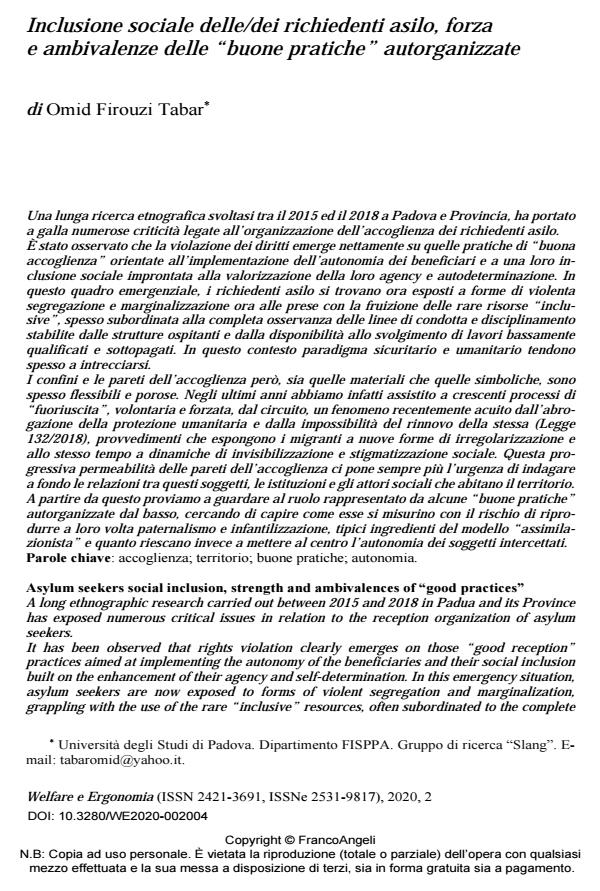Asylum seekers social inclusion, strength and ambivalences of "good practices"
Journal title WELFARE E ERGONOMIA
Author/s Omid Firouzi Tabar
Publishing Year 2021 Issue 2020/2
Language Italian Pages 19 P. 31-49 File size 233 KB
DOI 10.3280/WE2020-002004
DOI is like a bar code for intellectual property: to have more infomation
click here
Below, you can see the article first page
If you want to buy this article in PDF format, you can do it, following the instructions to buy download credits

FrancoAngeli is member of Publishers International Linking Association, Inc (PILA), a not-for-profit association which run the CrossRef service enabling links to and from online scholarly content.
A long ethnographic research carried out between 2015 and 2018 in Padua and its Province has exposed numerous critical issues in relation to the reception organization of asylum seekers. It has been observed that rights violation clearly emerges on those "good reception" practices aimed at implementing the autonomy of the beneficiaries and their social inclusion built on the enhancement of their agency and self-determination. In this emergency situation, asylum seekers are now exposed to forms of violent segregation and marginalization, grappling with the use of the rare "inclusive" resources, often subordinated to the complete observance of the lines of conduct and regulation established by the host structures. Moreover, access to the above-mentioned resources may be subject to the asylum seekers availability of performing low-skilled and underpaid jobs. In this context, the security and humanitarian paradigm often tend to intertwine. However, the borders and walls of reception, both material and symbolic, are often flexible and porous. In fact, in recent years, we have witnessed growing processes of voluntary and forced "escape" from the reception system, a phenomenon recently exacerbated by the repeal of the humanitarian protection and the impossibility of renewing it (Law 132/2018). Such measures have exposed migrants to new forms of irregularization and at the same time to dynamics of invisibility and social stigmatization. This progressive permeability of the reception walls increasingly urges us to investigate the relationships between these subjects and the institutions and social actors that inhabit the territory. Starting from these considerations we would look at the role represented by a few grassroots "good practices", trying to understand, among the various ones, how they face the risk of recreating paternalism and infantilization, typical ingredients of the "assimilationist" model, and how much they manage to put the autonomy of the intercepted subjects at the core of their work.
Keywords: Reception; territory; good practices; autonomy.
Omid Firouzi Tabar, Inclusione sociale delle/dei richiedenti asilo, forza e ambivalenze delle "buone pratiche" autorganizzate in "WELFARE E ERGONOMIA" 2/2020, pp 31-49, DOI: 10.3280/WE2020-002004